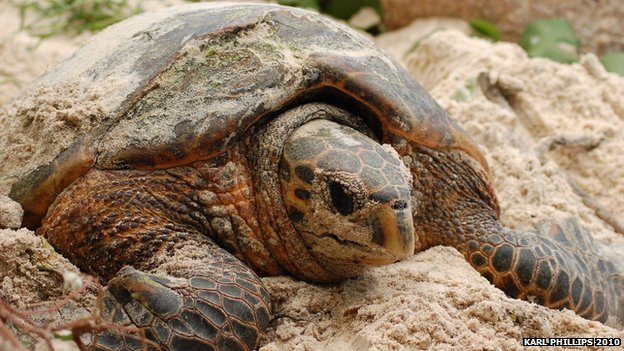
Female Hawksbill turtles are monogamous.
Because “New insight into Hawksbill Turtles’ mating patterns” or “Hawksbill turtles’ monogamous sex life revealed” sounded creepy and overfamiliar.
Dr David S Richardson and Karl Phillips from the University of East Anglia looked at turtle nests on Cousine Island in the Seychelles, an eco-tourism holiday destination favoured by the rich and famous.
Working with the islands’ conservation staff they used a non-harmful procedure to collect DNA from the hard skin of the flipper, or around the shell.
The researchers looked at 43 mothers and 1600 young to reconstruct a genetic model of each nestling’s father, without having to catch the males out at sea. ‘It’s important to do this so that we can understand their mating system and see how much genetic variation there is within the population’ says Richardson.
This is the first comprehensive study into Hawksbill Turtle mating patterns and the findings may help conservationists refocus efforts to where they’re needed.
…
The scientists were surprised then to find all of the eggs from an individual female are normally fathered by the same male. This means the mothers mate only once and then store the sperm for the entire mating season, fertilising all their eggs with it.
Monogamy in the animal kingdom is the exception rather than the rule. Many females are forced to mate multiple times by aggressive males, or prefer to mate multiply to ensure they have the best quality sperm.
'If they mate with one male and then met another one that was in some way better, bigger or stronger, they might re-mate and have a mix of eggs fertilised by both,’ Richardson explains. 'However, it seems female Hawksbills would rather mate just once, far away from their nesting site, then store the sperm, perhaps to avoid unwanted male attention.’
…
Now the scientists know that not only are there lots of males fathering the nestlings, but there are many male turtles scattered far across the Indian Ocean. Conservationists can use this information to widen their efforts, from the beaches where the females lay their nests to the entire Indian Ocean area, in order to protect males too.
By Harriet Jarlett | Planet Earth Online
marpar12 reblogged this from scinerds
understormywaters reblogged this from mad-as-a-marine-biologist
foxlikesly liked this
 allentownjail reblogged this from scinerds
allentownjail reblogged this from scinerds kmanovaere liked this
of-the-north reblogged this from reptilefacts
jeancarlo09-blog1 reblogged this from reptilefacts
funfetticats reblogged this from reptilefacts
lmactans liked this
amandamals reblogged this from laprasreptilesandstuff-blog
laprasreptilesandstuff-blog reblogged this from reptilefacts
laprasreptilesandstuff-blog liked this
reptilefacts reblogged this from moreanimalia and added:
Female Hawksbill turtles are monogamous.
wified liked this
randomthingsandideas-blog liked this
lala-loki-licious-blog liked this
jenn2d2 liked this
snotboogie liked this
yan-tonz liked this
moreanimalia reblogged this from mad-as-a-marine-biologist and added:
Female Hawksbill turtles are monogamous.
 ats0up liked this
ats0up liked this brian-my-left-testicle liked this
shark-bait-ooh-haha reblogged this from mad-as-a-marine-biologist
ahudsoncalledpierson liked this
 private-eden reblogged this from scinerds
private-eden reblogged this from scinerds blissy-leaves liked this
a-little-harmed-shinra liked this
 giltynami reblogged this from scinerds
giltynami reblogged this from scinerds chrysostmomhasmoved reblogged this from mad-as-a-marine-biologist
2minichinz liked this
 clotheshater liked this
clotheshater liked this mystuffinprogress liked this
 champlainguy liked this
champlainguy liked this  ucsdhealthsciences liked this
ucsdhealthsciences liked this mad-as-a-marine-biologist posted this
- Show more notes
